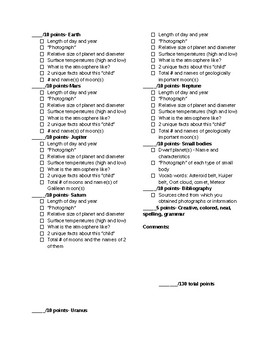Solar System Baby Book
Savanna Haire
4 Followers
Grade Levels
6th - 8th
Subjects
Resource Type
Standards
NGSSMS-ESS1-2
NGSSMS-ESS1-3
Formats Included
- Word Document File
Savanna Haire
4 Followers
Description
I created this project for my middle school Earth Science class. We were in our astronomy unit and I did not want to lecture over every single aspect of our solar system since each student is at varying degrees of familiarity with it. So, I put together this "Solar System Baby Book" that includes information on the sun, rocky planets, gas giants, and small bodies. It allows students to be creative while they demonstrate their knowledge of the subject.
Total Pages
Answer Key
N/A
Teaching Duration
N/A
Report this resource to TPT
Reported resources will be reviewed by our team. Report this resource to let us know if this resource violates TPT’s content guidelines.
Standards
to see state-specific standards (only available in the US).
NGSSMS-ESS1-2
Develop and use a model to describe the role of gravity in the motions within galaxies and the solar system. Emphasis for the model is on gravity as the force that holds together the solar system and Milky Way galaxy and controls orbital motions within them. Examples of models can be physical (such as the analogy of distance along a football field or computer visualizations of elliptical orbits) or conceptual (such as mathematical proportions relative to the size of familiar objects such as students’ school or state). Assessment does not include Kepler’s Laws of orbital motion or the apparent retrograde motion of the planets as viewed from Earth.
NGSSMS-ESS1-3
Analyze and interpret data to determine scale properties of objects in the solar system. Emphasis is on the analysis of data from Earth-based instruments, space-based telescopes, and spacecraft to determine similarities and differences among solar system objects. Examples of scale properties include the sizes of an object’s layers (such as crust and atmosphere), surface features (such as volcanoes), and orbital radius. Examples of data include statistical information, drawings and photographs, and models. Assessment does not include recalling facts about properties of the planets and other solar system bodies.



